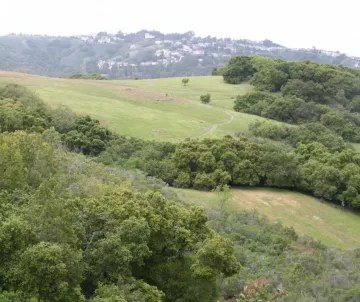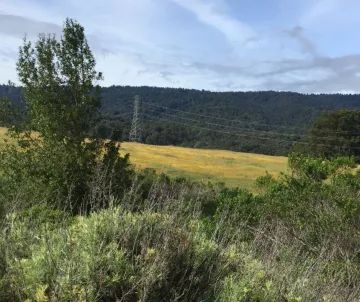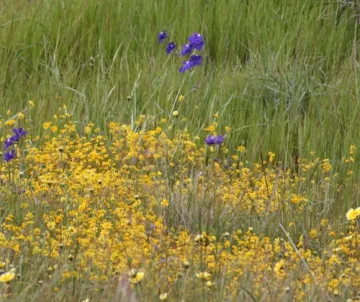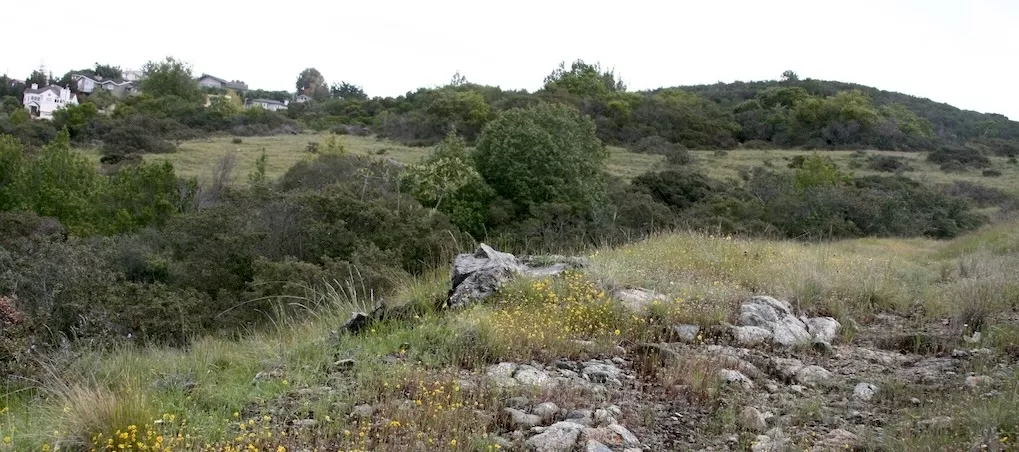
The grasslands of Edgewood Park and Natural Preserve are famous for their magnificent displays of wildflowers each spring. The park's location, within easy access to Interstate 280 and Edgewood Road, makes this beautiful display readily accessible to the population centers of the San Francisco Peninsula. The Park's 467 acres of woodlands and grasslands afford wonderful hiking and sightseeing opportunities.
The geologic history of Edgewood is traced back over 35,000 million years ago when the rock that underlies much of this region was formed by two converging tectonic plates, the Farallon and North American. The Farallon plate was forced under the American plate and large amounts of rock were left behind. One, serpentinite, is a very rare rock type that is found at Edgewood. This underlying rock is a very unique feature of the Park that can be observed in the serpentine grasslands and rock outcroppings.
The vegetative history of Edgewood reflects numerous geologic and climatic changes. Evidence of Neotropical, Actotertiary, and Madroteriary forest are found there.
The human history of the region shows that hunters were in the region 6,000 years ago. Two Ohlone archeological sites have been found nearby, one at Filoli Estates and one at Phleger Estates. In 1769, the Spanish exploring party of Gaspar de Portola marched through the region and made the first Ohlone-Spanish encounter.
Wetland, Grassland, Oak Woodland, and Chaparral plant communities offer varied habitats for living creatures found in the park. The central portion of the park is dominated by a prominent ridge about 800 feet in elevation, affording outstanding views of Skyline Ridge, Huddart Park, the San Andreas Gulf Zone, the Crystal Springs Lakes and the San Francisco Bay. This ridge typically supports Chaparral on its warm western slope, and Oak Woodland on its less exposed cool eastern slopes.
Species

Deer, coyote, bobcat, raccoon, and other small animals are frequently sighted. The cool, wooded gullies of the eastern slope of the park are rich in ferns and mosses, and a thick layer of woody and herbaceous plants. The grasslands and warm summer climate make Edgewood home for several species of snakes and reptiles including rattlesnakes. Skunks, yellow jackets and bees are also found there. Please respect their presence and avoid contact. Ten rare or endangered plant species have been identified in the park, including the San Mateo Thornmint. It once graced the hills of the San Francisco Bay Area before development destroyed most of its habitat. Many majestic trees and colorful plants adorn the Park. The California Native Plant Society's Flora of Edgewood Park lists the remarkable diversity plant species found here. The Bay checkerspot butterfly, once an inhabitant of the entire Bay Area, and now listed as an endangered species, is found only in this park, in Kirby Canyon in southern Santa Clara County, Coyote Ridge in San Jose, and San Bruno Mountain State and County Park in northern San Mateo County. All of these rare plant and animal species are protected in the Park and Preserve, and their habitats may be off limits to park users. Please observe signs carefully, and stay on designated trails.
Value as Water Supply
The West River and Edgewood Park Pond have a water quality classification of A. Designated uses include a potential drinking water supply, habitat for fish and other aquatic life and wildlife, recreation, navigation, and industrial and agricultural water supply. Both segments are impaired due to elevated bacteria concentrations, affecting the designated use of recreation. As there are no designated beaches on these segments, the specific recreation impairment is for non-designated swimming and other water contact related activities.
Value as Flood Control
Beautification work has been done for Edgewood to provide flood protection. The Edgewood Park Improvement Program was centered around dredging channel widening work on a portion of the West River. The aim of the overall program was to beautify isolated sections of the park and to create additional facilities for the public, a direct result of the dredging work was to lower any flood threat in the area surrounding the park. Besides dredging the section of the river that runs through the Dark from Whalley Avenue to Derby Avenue, the New Haven Park Department built a new drive from West Rock Avenue into the archery field, rebuilt the old road to the Park’s athletic field; terraced the widened banks of the river and planted wild flowers on them, and developed areas for picnicking. An eighth to 16 inch drop in water level of the West River resulted from the dredging operation.

Local Organizational Involvement
In 2003, PG&E proposed a new 230 kV Jefferson-Martin transmission line which involved new, taller towers and associated long-term disturbance in Edgewood and the adjacent San Francisco Watershed. Committee for Green Foothills, and other groups including Sierra Club, Friends of Edgewood, and the California Native Plant Society, called for undergrounding the new lines. After more than a year of advocacy, the State Public Utility Commission revised PG&E’s original proposal and required undergrounding the new transmission lines under Cañada Road and Skyline Boulevard, thus sparing Edgewood and the San Francisco Watershed from the adverse impacts to scenic, recreational, and environmental values.
Donald H. Mayall, a 35 year member of the Sierra Club, who was instrumental in the establishment of Edgewood Park sadly passed away on June 28, 2017, after a brief illness. He was 85. After moving to Palo Alto in 1979, he joined the local chapter of the California Native Plant Society in the mid-1980s, quickly rising to leadership positions, including chapter presidency and chair positions for field trips, rare plants, invasive exotics and more. He was in the first class of docents at Edgewood County Park (San Mateo County), whose serpentine soils give rise to dazzling displays of native flowers, some rare. Along with his wife, Carolyn Curtis, he participated in the campaign to make Edgewood a natural preserve; that effort succeeded in 1993. He went on to advocate successfully for preservation status for another area with similar rare plants, Coyote Ridge, south of San Jose. His work surveying, mapping and working with scientists from many disciplines led to a large base of knowledge about the Coyote Ridge serpentine habitat. This solid scientific base played a key role in its preservation.
Don was a member of the Board of Directors of the Midpeninsula Access Corporation (MPAC) from 1987 to 1995, for which the Palo Alto City Council honored him in 1995. Also during those years, he was an active member of a video coalition of twenty local environmental organizations, producing and directing half-hour panel discussions and other programs that were aired biweekly on local public access television. One of these was a program on Edgewood, filmed on location and including footage he had taken.
Don's wife Carolyn Curtis was also involved with the CNPS and initiated a grassroots campaign to garner mass community support and political allies towards the preservation of Edgewood, which succeeded in 1993. After Edgewood Park was saved, Carolyn became the founding President of Friends of Edgewood Park and held this title for three years. Today, Carolyn remains a member of both CNPS and the Sierra Club. She indulges her love for open space and wildflowers by participating in walks with the Napa chapter of CNPS and by tending to her personal garden of native plants. The Loma Prieta Chapter would like to publicly thank Carolyn for her crucial role saving Edgewood Park and creating a model used to protect other lands, like Coyote Ridge Open Space Preserve.
Resources
Friends of Edgewood offers docent training programs, guided hikes, and other volunteering opportunities.
